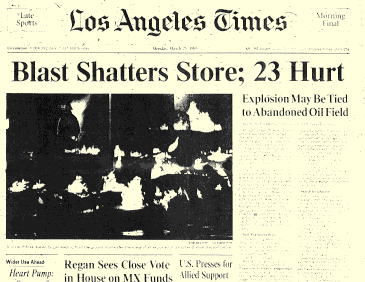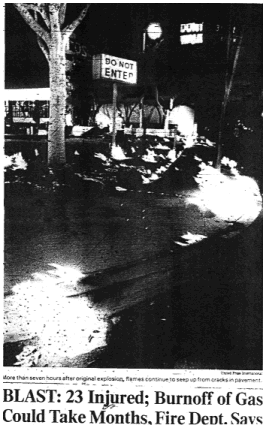
Paper to be presented at Meeting of the
Pacific Section Convention American Association Petroleum
Geologists
and
Western Regional Meeting of the Society of Petroleum
Engineers
Westin Hotel, Long Beach
8 am Tuesday June 20.
Session: "Environmental Liabilities Associated with Oil
Industry Operations".
Methane dangers in Los Angeles linked to waste disposal
in old oilfields
Studies of past oilfield hazards in Los Angeles show that
the most severe hazards above old oilfields are associated with disposal
of production wastes and attempts to give new life to old fields by repressurizing
the ground, according to studies by two experts who have analyzed the history
of hazards present in the Fairfax and Baldwin Hills areas. "Both the failure
of the Baldwin Hills Reservoir in 1963 and the Fairfax Gas explosions of
1985 occurred following initiation of waste disposal or secondary recovery
operations by pressure injection of oilfield wastewater back into the fields,"
said Douglas Hamilton, a geologist who has been studying these events for
the past decade. To an increasing degree much of the fluid that is produced
by oilwells in old fields is gassy salt water that has no use and must
be disposed of. The discovery in the late 1950s that the waste could be
pumped back down into the ground, and that the undergound balloon of pressure
would actually force more oil into oil wells was a boon to the oil industry.
"But the history of past disasters backed by mathematical modelling studies
now show that use of excessive pressure will cause gas and water
to burp back up from thousands of feet below the ground," according to
Richard Meehan, who teaches courses on environmental hazards at Stanford
University. The rush to develop land areas over oilfields and the controversial
siting of the Belmont Learning Center at the edge of Los Angeles' oldest
field and development proposals in the Playa Vista wetland area have raised
new concerns about methane hazards. Repressurization and waste disposal
have not been attempted at the field beneath the Belmont Learning Center,
though these operations are being conducted at another newer oilfield located
beneath the downtown part of the city. Natural processes of repressurization
and earthquakes could also result in methane releases, but the hazard is
much greater when waste disposal is active. The important thing is to maintain
injection pressures at safe levels and also understand the various pathways
that gas and fluid might take to reach the ground surface, according to
the experts.
Abstract of the paper to be presented follows.
Explosion and other gas ventings at the Fairfax District,
Los Angeles
by Douglas H. Hamilton Consulting Geologist 2 Bassett Lane, Atherton
CA 94027 tel 321-3071 and Richard L. Meehan 777 Hermosa Way, Menlo Park,
CA 94025, Adjunct Professor Stanford Univ tel 650-323-0525 meehan@stanford.edu
Methane gas ventings in the, Fairfax District of Los Angeles resulted
in the explosion of a Ross Dress for Less department store in 1985, and
the evacuation of several buildings in 1989. The Fairfax District overlies
part of the old Salt Lake oil field and is about one-half mile from the
LaBrea Tar Pits. The oil field, once developed by more than 400 wells,
was largely abandoned prior to being redeveloped by slant drilling starting
in 1962. Since then production of oil, salt water and gas has been continuous
with the water being reinjected into the field since 1980. The disposal
reinjection was into a block adjacent to te Third Street fault which projects
to the surface near the surface venting sites. Injection was at surface
pressures of up to 770 psi giving rise to a gradient of about 0.7
psi/ft within the subsurface near the point of injection. We conclude that
this resulted in episodic fracturing of the Third Street fault.
The fault acting as a valve structure, was temporarily jacked open by
the local fluid overpressure and while open served as a conduit for escape
of pressurized methane to the near surface. With depressurization the fault
conduit would collapse and the venting cease. Similar effects of fault
activation by fluid pressure excursions have been demonstrated in connection
with the 1963 failure of Baldwin Hills dam in the Inglewood field, with
seismicity triggering elsewhere, and also in geological paleoeffects preserved
in vein structures.
Clearly the phenomenon of methane venting in the urban environment can
be hazardous, especially if no provision has been made to control it at
the surface. But we propose that an adequate response to this hazard should
include developing an integrated understanding of both surface and subsurface
condifions, starting, where oil field activity is involved, with the geology
and operations within the producing zone.
Other old oilfields such as the Los Angeles field have not been subject
to artificial repressurization and do not present the same explosive and
ground rupture hazards which accompanied reinjection of wastes at the Salt
Lake and Inglewood fields. Potentially hazardous migration of gas to the
surface at these locations would be controlled by diffusive or natural
repressurization processes operating in conjunction with primary or secondary
permeability characteristics of the upper few thousand feet of rock or
via abandoned wells.
Some illustrations follow:
Fairfax area gas
ventings, 1985

Nighttime gas release, near Ross
store.

Relation of explosion site to
Los Angeles landforms

Fluid injection and the Baldwin
Hills reservoir





